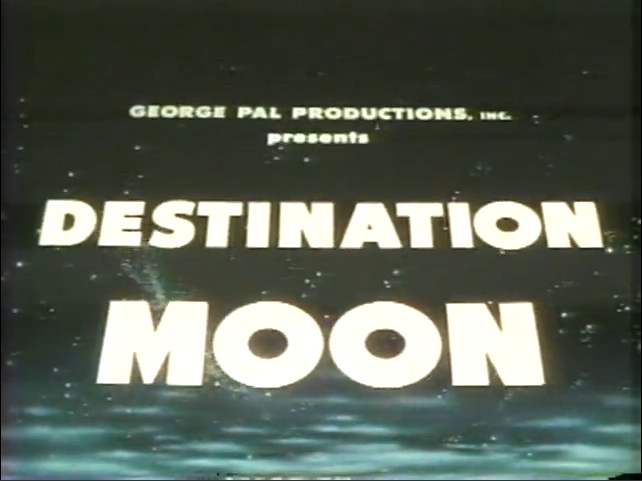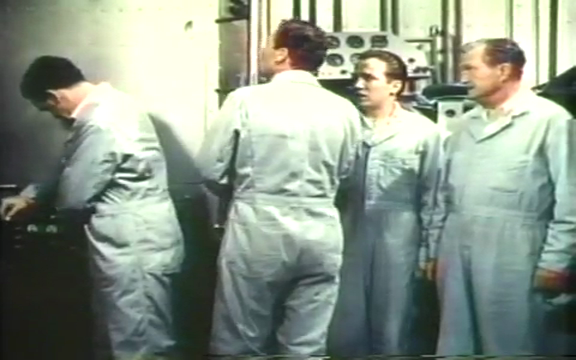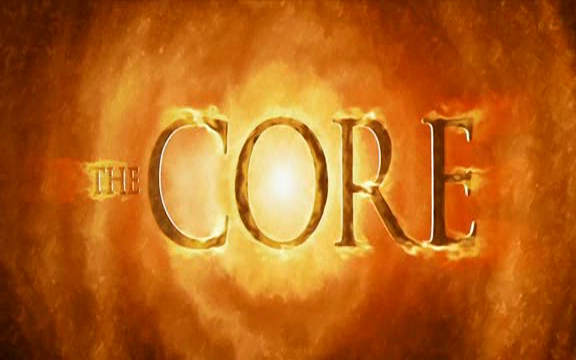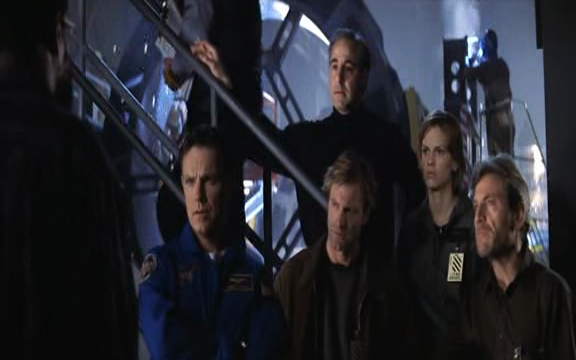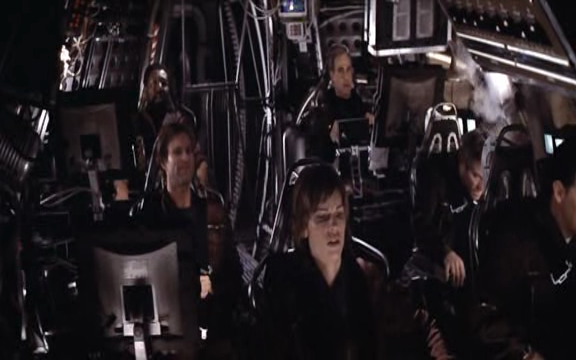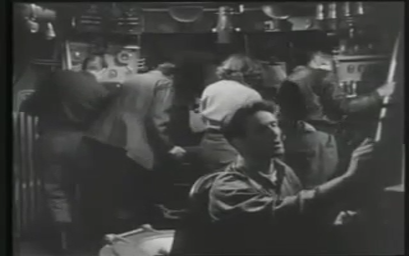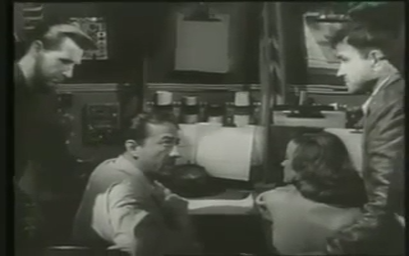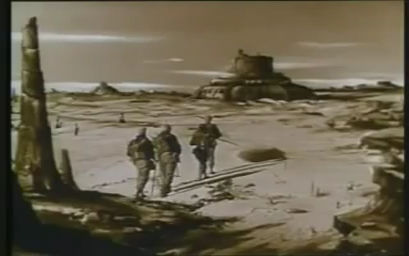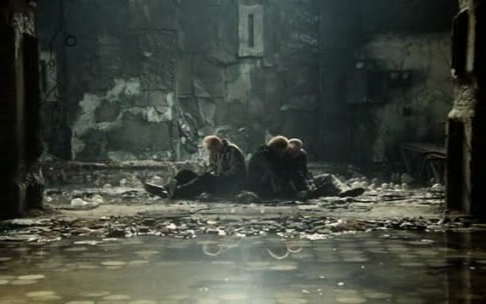-
#28 – Destination Moon (1950)
Destination Moon (1950)
Film review #28
Directors: Irving Pichel, Walter Lantz
The first science-fiction movie to be produced post WWII about a trip to the moon…
As the latest test launch of a V-2 rocket fails at a top secret launch site in America, government funding is pulled and rocket scientist Dr. Charles Cargraves, and General Thayer have to rethink their plans. They hire Jim Barnes to aid them in creating a rocket that can take them to the moon. They persuade a group of corporate American investors and captains of industry to fund the project. At first skeptical, Cargraves convinces them that they are not the only ones who want to get the moon, and that whoever can put missiles on the moon first will control the Earth…
Two years pass and the rocket is just about ready for takeoff. Fear has been building in the media that the rocket may cause a number of consequences to the public, including radiation, so Cargraves steps up the launch schedule to avoid giving the government time to stop them, since “There are no laws against launching a space rocket yet.” Cargraves, Thayer and Barnes are joined by Joe Sweeney, who handles the radio and communications equipment in the shuttle. He does not believe that the rocketship will work, and only agrees to join in just to prove this. While they are making final preparations, a government official tries to gain access to the launch site with a court order, banning the rocket from launching. Cargraves hears of this and quickly rallies his crew into the rocket and to take off before the official can reach them, feigning ignorance of why he is there.
As the rocket takes off, the crew experience the G-force from launching, and start to experience weightlessness. They take a pill to counteract the feeling of “spacesickness”, and take a look out of the window to see the Earth moving away in the distance, as Sweeney still can’t believe the rocketship worked, telling the others he wants to head back because the moon is just “something to look at”. While travelling through space, they find that one of the antennas has frozen, and they have to take a walk outside the shuttle to go and fix it. They very nearly lose a crewmember as he drifts off into space, but another crewmember uses an oxygen tank as a propulsion device to go and rescue him, and the four continue on their voyage to the moon.
Upon making a successful landing, the crew head out onto the surface, and Cargraves claims the moon “In the name of all mankind”. They then receive a transmission from Earth, and are interviewed for a broadcast to be sent all over the world. The team then splits up to research the different aspects of the moon. Cargreaves photographs Sweeney seemingly holding up with Earth, like a “Modern day Atlas”, and Thayer takes some mineralogical surveys, finding a large uranium deposit on the moon.
Back at the ship, Barnes is calculating the take off with Earth, and comes to a troubling conclusion: The rocketship is too heavy to take off and make it back to earth. He goes outside to report this to the other crewmembers, and they spend the next 24 hours stripping the ship to make it lighter. In the end, they are still 110 pounds too heavy, and they decide they have to leave someone behind, and decide to draw lots between Thayer, Cargraves and Barnes. Sweeney goes outside while they argue and decides to sacrifice himself. Cargraves then comes up with a plan to take out the radio and to close the airlock without someone having to do it manually, so they can throw out the last spacesuit, leaving the rocket light enough to take off from the moon and towards Earth. The film finishes with the phrase on screen: “This is the end…of the beginning”.
Destination Moon was the first movie to be put into production post WWII about space travel. It was not the first released however, as when it was delayed, Rocketship X-M was quickly produced and made in under three weeks to beat Destination Moon to release and ride the hype it had created (As I discussed in my Rocketship X-M review). Destination Moon is a slick and carefully considered movie about the prospects of space travel, and the movie tends to being as accurate as possible in terms of technology and science. For this reason, there are no robots, aliens, monsters or UFOs which dominated science-fiction at this time in the movie, but it is billed as a semi-documentary with regards to it’s execution. The plot and feels almost secondary to the science.
When this movie was released, the general public had very little idea what space travel would be like (The first man-made objects hadn’t even reached space yet), and the movie does it’s best to be informative and speculative at the same time. This is accomplished in a number of ways, firstly when Cargraves is trying to get the captains of industry to invest in the rocket, he shows them a Woody Woodpecker cartoon, which explains the whole concept of how the rocket works in this colourful and simple way not just to the investors, but to the audience too. Also the character of Joe Sweeney, played by a comedian acts as the “everyman” aboard the crew, with the rest being scientists or experts in their field. He is perhaps the most relateable character, with his distinct Brooklyn accent and his lack of knowledge about space travel, the other crewmembers have to explain to him what is happening throughout the journey, and the audience learns what is happening along with him. The speculative nature of the film reminds me very much of Contact, which itself is about the “What-ifs?” about first contact with extraterrestrial intelligence.
When this movie was released, it was billed as a high budget production. Just the fact that it was released in colour in 1950, when very few films were, is a testament to this. Though expensive and accurate in it’s time, nowadays it looks very much out of date. The moon set is a large 13ft matte-painted landscape, with holes cut out and light shined through them to create stars. This was an often practiced technique at the time, but nowadays looks rather crude. Since we have now put man on the moon unlike when this film was made, we can see that the film comes somewhat close to capturing the bleakness of the lunar landscape, but not close enough when compared to actual photographs taken from the moon, and our suspension of disbelief when looking back at this film cannot be maintained.
Overall, I would say that Destination Moon was a pretty important film for it’s time. It attempted to accurately speculate what a trip to the moon would be like, without there being any successful attempt to get into space at the time. We can look back on it now and pick apart the discrepancies between this and actual space travel. It shows that space travel is both a fantastic adventure and a perilous one, supported by a story that has comedy, drama and speculation altogether makes it is a bit of cinematic history. It is a little bit of a departure from the “disaster” sci-fi movies of that era, where there was always a monster or alien race looking to wipe out the Earth, and it is perhaps a refreshing change: One of hope and prospect rather than the terror associated with scientific and technological advances as portrayed in other films of the same era. This departure makes it stand out from the others, and if you want to watch a movie from that era, it is worth your consideration, you might even learn a little something about space travel too.
-
#27 – The Core (2003)
The Core (2003)
Film review #27
Director: Jon Amiel
A sci-fi disaster film giving the B-movie sci-fi movie plots of yesteryear a big Hollywood makeover…
A number of strange incidents are occurring all over the planet, including people’s pacemakers stopping, pigeons falling out of the sky, and calculation errors aboard a U.S. space shuttle. Dr. Josh Keyes, along with his friend Serge Leveque do some investigating and find that the only explanation is that the Earth’s core has ceased it’s rotation, causing the magnetic field of the planet to disappear. Alarmed at what they find, they approach a top government scientist, Conrad Zimsky to confirm their findings. He unfortunately has to agree with the results. At a government meeting, the three explain to the politicians that if something is not done to restart the core’s rotation, the planet will succumb to a series of disasters and become completely irradiated without the Earth’s magnetic field to protect it from cosmic rays. Their plan: To plant a series of nuclear charges in the core to restart the core’s rotation, but in order to do that, they will need to travel to the centre of the Earth, which seems impossible. However, Zimsky has an idea…
Keyes, Leveque and Zimsky travel to the salt plains to Utah to meet a scientist named Ed Brazzelton (nicknamed “Braz”) who shows them his plans for a ship that could travel to the core, and an ultrasonic laser which could drill it’s way there. The ship would survive by being constructed with an element he has jokingly named “unobtanium”. He is reluctant to work with Zimsky, who took credit for his research some twenty years ago, but is swayed to construct this ship for them when they offer him the fifteen billion dollars needed to build it. Joining them is Rebecca “Beck” Childs, the pilot that helped save the Endeavour shuttle from crashing into L.A. earlier in the film, and her mentor and commander Robert Iverson to round off the crew, and the six of them train to complete their mission to save the planet, helped by Theodore Donald “Rat” Finch, a hacker who suppresses information on the internet to avoid mass panic and keeping the public from finding out what is happening to the planet.
When the ship is finally completed, the team have no time to lose and prepare to set off. Braz has named it Virgil, after the poet that guided Dante through Hell and to the centre of the Earth in the epic poem The Divine Comedy. As they travel through the Earth’s mantle, they enter a geode and get stuck on a crystal like structure. Braz, Keyes and Iverson exit the ship to cut the crystal away from the ship, but it is a race against time as the geode is starting to fill with magma from the hole the ship made. The crystal is cut, but a piece of falling crystal pierces Iverson’s helmet, killing him instantly. The ship sets off again, but is soon hit by a huge diamond, damaging one of the compartments. Leveque sacrifices himself to get the nuclear launch codes out the compartment of the ship that is jettisoned and crushed. Keyes screams to Beck to open the bulkhead and let him rescue Leveque, but Zimsky warns her not to, and she listens, much to Keyes’ anger at feeling he could have saved his friend.
When they head into the outer core, they find a severe flaw in their original plan, the density of the core means that they don’t have enough firepower to restart the core. Zimsky radios to the surface to activate DESTINI, a secret project that could propogate earthquakes through the Earth’s core. Keyes refuses to abort their mission, meaning that when DESTINI fires, it will destroy Virgil. Zimsky snaps at Keyes saying he has no plan and he is going to kill them all. While Braz and Keyes are trying to figure out a plan unsuccessfully, Zimsky interrupts and comes up with one of his own: To eject each of the nuclear bombs in a seperate section of the ship at seperate times to create a cumulative ripple that will have enough power to start rotation. Keyes contacts Finch to hack into project DESTINI and delay it to allow time for them to complete their mission. Braz remarks that someone needs to deactivate a safety switch to jettison compartments manually, and whoever went would die because of the extreme heat in the tunnel. Braz himself volunteers and dies shortly afterwards.
As they are jettisoning the compartments, Zimsky and Keyes realise that the final bomb does not have enough power to accomplish their mission. Zimsky then becomes trapped in a compartment, and tells Keyes to use the plutonium that’s powering the ship to create enough power in the final bomb before the bulkhead shuts and Zimsky is jettisoned with the ejected compartment. The ship is now trapped without power, but Keyes has a plan to rig the unobtainium up like a solar panel to power the ship through the planet, the explosions successfully start the core rotating, and they arrive out of the core at the bottom of the ocean. They think they are lost their without power, until Finch finds them by tracking the whales circling the vessel. Keyes remarks that no one will ever know how close the planet came to destruction, and of the sacrifices of Iverson, Leveque, Braz, and Zimsky. That is, unless someone manages to leak that information. One week later, we see Finch sit down in an internet café, and uploads the details of what has happened onto the internet, and revealing the noble sacrifices of the heroes that saved Earth…
The Core is very much a big budget Hollywood take on the plots and concepts of old B-movies such as The Day The Earth Stood Still or War of the Worlds, in which a disaster is affecting the entire planet. The big difference between The Core and it’s predecessors has to be the use of special effects: Being able to convincingly create the image of a ship tunnelling through the Earth, or a freak thunderstorm wiping out Rome and the colosseum really drives home that sense of disaster. These special effects weren’t really cutting-edge for their time, but compared to the B-movies of yesteryear, they are amazing, and one might wonder what those old movies would look like with a Hollywood makeover (Then you should remember some of the recent Hollywood remakes that were terrible, and should forget all about that idea…). Despite the scale the disaster is shown on though, I found the movie to be a fairly easygoing affair, and quite an enjoyable journey. When I first saw that the movie was two hours long I figured I was going to either have to wait a while for it to get going, or I’d get bored half way through, but that never happened. The movie starts off strong and eases you in to a comfortable pace with some well defined characters with enough personality that makes those two hours really enjoyable. Not stand out amazing, but enjoyable.
This movie wasn’t so successful in the U.S. when it was launched, and only turned a profit when it was released worldwide. The main reason this movie is remembered is because of it’s numerous scientific inaccuracies, and is often slammed by scientists (In a poll which asked scientists about the worst science-fiction films, The Core was voted the worst). There are a lot of liberties taken with science in this movie, so it’s difficult to pick just one out. I suppose the worst offender would be that the loss of the core’s rotation would not have the effect it has in the movie: Pigeons would not start falling out of the sky, pacemakers would not just shut down, and “superstorms” would not occur and wipe out entire cities. If the core did stop rotating, the immense energy from the rotation would instead dissipate outwards into the mantle and evaporate the oceans, which would be a much more serious issue. The energy needed to theoretically restart the core (Which isn’t possible, since it just wouldn’t stop) would be equivalent to 500 times the amount of nuclear weapons in the world, rather than the 5 they use in the film. The worst effect of the core ceasing rotation in the movie is the loss of protection from “cosmic rays” that the magnetic field gives. While this is partly true (depending on what type of “cosmic rays” one refers to), the movie refers to “microwaves” being the main problem, but in fact microwaves aren’t affected by magnetic fields, and the sun does not put out enough energy in microwave form to make much difference anyway.
If you know nothing about any of these concepts, you can perhaps just accept them and enjoy the film, and indeed, the film is still enjoyable despite the errors. The trouble with this (and other movies like this), is when you centre a plot around science, the audience is encouraged to think scientifically, and when one does that, everything becomes undone and the science doesn’t add up. In the film’s defence however, it does tend to not take itself too seriously, what with naming an element “unobtainium” for starters, and citing it’s cinematic predecessors, we can take the inaccuracies in jest, and enjoy the ride.
Overall, The Core is a fun ride, and an easygoing film that takes advantage of a large budget, stylish design and production values. While not a massive hit compared to similar movies such as Armageddon, it still holds it’s own. However, the sheer inaccurate portrayal of scientific knowledge throughout the two hours means you shouldn’t show this as an educational film to a class of high school children for it’s scientific value. Put that aside though, and you have a perfectly watchable film.
-
#26 – Doomsday Machine (1972)
Doomsday Machine (1972)
Film review #26
Director: Herbert J. Leder
A disaster film in more ways than one…
A pair of American spies infiltrate a secret Chinese research facility and discover a doomsday machine, which will be activated in 72 hours. They take photographs and report back to the American government.
Meanwhile back in America, the spaceship Astra is being prepared to launch on a two year trip to Venus. Their launch window has been stepped up, and three of the men of the crew have been replaced by three women, incuding one woman, at the last minute, which has baffled the crew. Soon after the launch of the ship, military alerts are placed in effect across the entire world. It then dawns upon the four men and the three women of the Astra that they have been put together to restart the human race on Venus should the Chinese “doomsday machine” be activated. Sure enough, they look upon the Earth as it destroyed through a myriad of nuclear strikes…
As the seven-person crew continue to Venus, they realise that the weight of the ship means that a safe landing on Venus is impossible, and that the crew must be reduced to three to make a successful landing. They entrust the machine to make the decision for them, much to the chagrin of one of the crew. Two of the crew are involved in an altercation, and accidentally open the airlock, killing them both. Furthermore, another two leave the ship to dislodge a faulty booster to ensure the ships landing.
The two crewmembers are drifting off into space when they come across an abandoned soviet shuttle from an earlier mission, and go to board. They find miraculously that the craft is still operable and attempt to communicate with the Astra. There transmission is cut out and they are unable to hail them. Then, a voice calling itself the “collective conscious of the population of Venus” tells the craft that the Astra is no more, and that humans cannot land on Venus, because they have proven to be dangerous and destructive species with the destruction of their home planet. The voice then talks ambiguously about their being life beyond the universe as the film suddenly ends…
This film seems to have been plagued by a number of problems during it’s production. Primarily being that the film ran out of money before it being completed. The film was made in 1967, but an ending wasn’t made until 1972, when the rights were bought and the film finally released. The original budget itself wasn’t much to begin with, leaving the film to be classified very much as a B-movie. That said, movies have been made of higher quality with less money than Doomsday Machine had ($700,000 to be exact). There are very few sets or special effects, and there was a lot of stock footage used in place of actually making anything original, so I do wonder where all the money went…
The movie itself is a very bleak and unhopeful one. The Earth is destroyed, and the last seven members of humanity are picked off as a consequence of their own selfish actions, or circumstances which they cannot control. The ending does very little to leave a feel-good message in the mind of the viewer either. It is a depressing “what-fi” secenario that is played out before us, and sugar coating it with a happy ending may have taken away that dire warning. Being released during the Cold War, it’s message would certainly had relevance when it was made. Looking back on it today with what we know now, we find the whole pot of the movie even more futile, being that we know that Venus has a ground surface of 425 degrees celsius, and is covered in poisonous sulphuric clouds, therefore making it impossible for ground-based life to exist there. This fact has been known since about 1963 by the Mariner 2 probe, so why this film chose to ignore this fact and change the story to a jpourney to Mars I do not know. It could be that this knowledge of Venus wasn’t publically known, so the film could get away with it. It could have something to do with more Cold War politics, and keeping this information suppressed out of the public realm. If a movie tried to do this plot nowadays, the general public would probably dismiss it outright as it is widely known (taught in schools even) that Venus is unable to support human life. I guess a remake is out of the question then?
There are a lot of errors, both scientific and continuity are prevalent throughout this film. One of the most obvious ones is that a number of different stock footages are used to show the spaceship Astra which are completely inconsistent. One scene shows a ship that is shaped like a rocket, another is actual degraded footage from a NASA space launch, and in another it is a strange spherical ship that looks like a space station. This confused me quite a bit as I just didn’t know what I was looking at most of the time. There is a lot of techno-babble in this movie too, with some scenes consisting of the crew reading off numbers and values which make no sense. It’s that old cliché that TV shows and movies can get away with making up science because the public will just accept it. In this movie though, the crew just reels off numbers and such for quite a while that it gets very tedious.
The most significant thing about this film is the ending. During the last ten minutes, everything suddenly changes. Due to the film being completed five years after production was halted, the original actors, costumes or sets weren’t available, so at that one point during the movie, it becomes something else entirely. The spacesuits the two crewmembers are in suddenly change appearence completely, and their hemets are coincidentally opaque (To mask the fact that the actors are completely different no doubt). The voices still give it away that they are not the same people, namely the woman seems to have completely lost her Russian accent. Out of nowhere this voice claiming to be the “collective conscious of the population of Venus”, hinted at nowhere in the movie ends the movie with an ambiguous monologue about the mysteries of the universe. It seems to me that the people that bought the movie to make an ending from it wanted to make it have that 2001 vibe, carrying the shuttle off to the distant reaches of the universe. Honestly though, it doesn’t really work on this budget, and not being set up for in the rest of the movie just leaves a sense of bewilderment rather than wonder.
Doomsday Machine is not a movie you would want to watch nowadays. Everything about it is outdated, the production is poor, and the ending makes no sense (in a bad way). The fatalistic events of this movie mean there is nothing feel-good here so you really can’t watch it for a laugh at the bad production. Unless you want to see a prime example of how not to make a movie, this one is a miss for me.
-
#25 – Rocketship X-M (1950)
Rocketship X-M (1950)
Film review #25
Director: Kurt Neumann
The first science-fiction movie post-WWII to be set in outer space…did it live up to the hype?
At a government facility, members of the media have assembled at a press conference. There, Dr. Fleming announces that within the next 20 minutes, they will launch the first manned spaceship, Rocketship X-M (Xpedition-Moon) into outer space and to the moon. He then introduces the five crewmembers who will be on board: Col. Graham, the pilot. Dr. Lisa Van Horn, chemist. Dr. Karl Eckstrom, the ship’s designer. Major William Corrigan, the navigator and Harry Chamberlain, engineer. The five of them answer questions put to them by the press before making their way to the rocketship…
Everything is going smoothly with the journey until the ship mysteriously loses it’s velocity and stops in space. Graham and Van Horn re-calculate the equations for the ships fuel balance, and when they finally finish, they adjust the fuel composition and the ship regains velocity. This success is short-lived however, as the ship goes much faster than anticipated, and the crew is knocked unconscious as the ship speeds off into space…
As the crew awakens, they find they have drifted way off course, and when they look out the window, they realise how far: They see the planet Mars. They surmise they are being pulled there by some mysterious force, and they decide to let “a force greater than themselves” pull them to the surface. When they land, some of the crew have reservations about venturing out, but they eventually agree that the scientific value of the exploration is too great to pass up, and the five of them set out to explore the surface. Mars is a barren planet, but eventually they find evidence of an advanced civilisation in buildings and metal statues. Wondering what could have happened, they then detect a large amount of radiation and it all becomes clear: Nuclear war had reduced an atomic age to ruin, a lesson that the crew thinks should serve as an important message and warning to the people of Earth.
The crew rests in a cave during the night, and while the rest sleep, Harry notices creatures in the distance. He wakes everyone up and they go and investigate. They find footprints, and Eckstrom and Harry go and investigate. Eventually, they find a gang of primitive men. What has happened on this planet is now clear: An atomic age has become a stone age, caused by nuclear war. The cavemen become violent, and start to attack the crew by throwing rocks at them. They kill Harry, and Dr. Eckstrom runs back to the other three and tells them to run to the ship. Under the constant rock throwing, Eckstrom is then killed, and Corrigan is seriously wounded, so Lisa and Graham carry him back to the ship.
Making it’s way back to Earth, Lisa and Graham are reflecting on their journey. Approaching Earth, they realise that don’t have enough fuel to land, and in an attempt to ensure their whole journey wasn’t in vain, they attempt one last contact with Earth. Dr. Fleming, who has been waiting for news of the ship since it lost contact with Earth. They transmit the correct fuel equation they made, and warned him of the dangers of Mars, and the horrible consequence of nuclear weapons. After the radio falls silent, Lisa and Graham hold each other as the ship enters the atmosphere and crashes into a mountain range in Nova Scotia…
In Fleming’s office, members of the press enter, eager to know the fate of the rocketship. Fleming confirms that the ship that crashed near Nova Scotia is the X-M. When the journalists ask him if the mission was a failure, he says that the mission proved so much about space travel and exploration, and a strong message about the fate of mankind and the use of nuclear weapons could save humankind entirely. He then remarks that “Tomorrow will see the construction of X-M2”, and that this is only the beginning, resolute that the sacrifice of the X-M crew was not in vain…
While this is technically the first movie to be released post-WWII about space travel, it did cheat a little. Essentially, the first movie was supposed to be Destination Moon, but when that film got delayed, Rocketship X-M was quickly shot in 18 days and rushed into cinemas, hoping to capitalise on the hype surrounding Destination Moon and steal a bit of it’s thunder.
Being shot in eighteen days, you can’t really expect a very high production value from this film, and it shows. Most of the film is set in the rocketship, so no need to build lavish sets, and the uniforms are seemingly leftover military attire (Wearing a tie in space? Sure why not…). It should also be noted that a lot of the on-location scenes on the surface of Mars and shots of the rocket were not in the theatrical release, and instead stock footage of the V-2 rocket was used, again primarily due to the the film being quickly rushed out to beat Destination Moon into cinemas. These extra scenes were shot about twenty years later, carefully recreating the costumes from the movies and an accurate rocketship model by film enthusiast Wade Williams.
This film is very easygoing. There is no massive conflict, or no adrenaline-fuelled action sequences, the narrative of the movie is an account of the space travel itself, and what would happen during transit. For a movie that focuses such much on the details of space travel, there are a lot of scientific inaccuracies present in the film. For example, the inconsistency of representing gravity and weightlessness: Though they encounter occasionally the phenomenon of weightlessness in that random objects start floating, the ship is always seen like a cockpit of an airplane, with the crews feet firmly on the ground. The sound of the fuel tank being jettisoned, and when the rocket passes through a meteor shower, these scenes are accompanied by a sound, which of course would be impossible in the vaccuum of space. Also, it is mentioned that the ship has “twice the amount of fuel needed” to complete the voyage. This would be impractical for actual flights, but it does support the narrative, and allows the rocket to return to Earth after it’s lengthy detour to Mars.
The way in which Mars itself is depicted is also aloft with inaccuracies. The rocky, and barren nature of the planet is rather accurate, but the crew walk around the planet with just oxygen masks on. This would be impossible on the actual Mars due to the difference in pressure, so one would need at least some eye protection, and the cooler temperatures would mean some form of insulating clothing would need to be worn. Most of these inaccuracies we can overlook, since this movie was made seven years before the first man-made satellite was launched into space (Sputnik-1), and eleven years before the first human (Yuri Gagarin). So with very little to go on, the movie explores the different effects and experiences of space travel, and conveys them to an audience, they lack the scientific accuracy we come to expect from spaceflight, but one one has to remember the historical context in which this movie was made, and overlook certain portrayals of weightlessness and such forth. Of course, the rushed nature of the film certainly doesn’t help.
regarding the historical context of the film, casually calling a press conference some twenty minutes before the launch of the rocket shows a somewhat naiveity in how space travel works. Some of the attitudes towards the only female crewmember, Lisa Van Horn highlight the sexist attitudes of the 1950’s too. however, I found it rather difficult to tell if it was addressing the issue, such as when Dr. Eckstrom tells journalists she was selected for her expertise, and not because she was a woman, and other scenes when she asks whether one of the crew believes she should stay home and bake all day, he replies “isn’t that enough?” I think the dialogue really walks the line between being controversial, addressive and offensive from today’s perspective, though back then it probably would not have been labelled as such.
The ending is where the whole movie takes a dramatic twist. For a movie that is mostly casual and uneventful for the first hour, the last fifteen or so minutes sees the rocketship crash, and all five crewmembers die, far from the happy endings one usually sees in movies from this era. After this tragedy though, the ending is one not of just tragedy, but also of hope. Through the crew bravery and curiousity, they have successfully flown in space, landed on a hostile planet, and warned Earth of the dangers of nuclear weapons. The scientific curiosity is here glorified, and there sacrifice is far from in vain. While the scientist was being traditionally portrayed as the sidekick or out of the main spotlight in American cinema, this ending is quite powerful and challenging in comparison to other films of the day.
Overall, I’d say Rocketship X-M is very much a film of it’s day: Back when one could shoot a film in eighteen days and get away with it. The film shows the visions and possibilities of space travel, at a time when such things were only pipe dreams. It also serves as a warning about the dangers of nuclear weapons, and the power they possess to throw civilisation back to the stone age. While probably not a film you might casually watch nowadays, it reveals a lot about the time and place it was set, which I think makes it a rather significant film culturally. Although the film is unmistakeably a 1950’s film, the ending takes a bold step in almost martyring the scientist, both curious and adventurous, working towards the protection of mankind…
-
#24 – Stalker (1979)
Stalker (1979)
Director: Andrei Tarkovsky
Another science-fiction film directed by Andrei Tarkovsky, exploring the mysterious “Zone”…
In a home, we find a wife and child of The Stalker: A man who is hired by people to lead them through “The Zone”: A strange place where the laws of physics no longer apply. Within The Zone, there is a place called The Room, where people can go to get there one true wish fulfilled. The Stalker’s wife pleads with him not to go again to that dangerous place, but he ignores her pleas.
Stalker is hired by two men to escort them to The Zone. At a local bar, he meets the men, calling themselves “Professor” and “Writer”, who wish to find The Room and make their wish. The three set off through a military blockade that surrounds The Zone, avoiding patrols and gunfire, and finding a railcar to take them into The Zone itself…
The three arrive in The Zone, which resembles an overgrown area of countryside, with ruined debris scattered around. The lack of any sound gives it away that there is something not quite right about where they are. Stalker tells Professor and Writer to follow his instructions exactly, or they will be killed. He ties nuts/bolts to pieces of cloth, and throws them in the direction he works out is the best way to travel, to test out the safety of the route. The Writer is constantly skeptical of The Stalker’s odd actions, but The Professor generally follows his advice.
The two men have different reasons for visiting The Room. The Writer finds himself lacking in inspiration to write, and is hoping he can re-ignite his passions, while The Professor is hoping he can win the Nobel Prize. The Stalker mentions his mentor, Porcupine, who lead his Brother to death in The Zone, and wished for riches in The Room. However, a week later, he hung himself.
After travelling via a route of overgrown fields, underground tunnels and sand filled rooms, the three arrive outside The Room. There, a strangely placed phone begins to ring. the Writer answers and tells the person on the other end “This is not the clinic” and hangs up. Next, The Professor dials a number on the phone to brag to someone on the other end, and hangs up. The Stalker warns them both that The Room does not grant the wish they ask aloud, but it grants the true unconscious wish that resides deep within them. After this, the Professor reveals the real reason he came to The Room: He pulls out a bomb, saying that the power to grant wishes could be used for evil and terrible deeds, and because man should not have such power, needed to be destroyed. The three fight physically, and after a while, the Professor backs down from his plan, and the three sit down on the ground in defeat, none of them wishing to head into The Room and dare to have their wishes fulfilled…
Back in town, the three men are sitting in the bar where they first met. Stalker’s wife comes in and sees a dog that had got attached to Stalker and had followed him out of The Zone. Stalker then leaves the bar with his wife, the dog, and his child “Monkey”, who it was hinted at the start of the movie and now confirmed that she cannot walk on her legs without support (apparently she was born this way, and is a consequence of her father being a Stalker).
At home, Stalker’s wife tells him she has considered visiting The Room herself. Now, Stalker is having doubts about The Zone’s nature, and worries that her wishes would not be fulfilled. In a monologue to the camera, the Wife talks about whether she should leave Stalker, and the choices she has made by staying with him. She eventually re-confirms her commitment to him, while in the kitchen, Monkey sits at the table reciting a poem, she them apparently moves three glasses with the power of her mind (psychokinesis), and after the third glass falls to the floor, a train is heard going past the house, which causes it to shake…
A bit of background about this movie…this is another movie by Andrei Tarkovsky, most famously known for his 1972 movie Solaris. A lot of the production techniques used in that movie, such as long shots, steady camera motions, a slowly revealed plot, and a sparse and minimal soundtrack, were according to Tarkovsky himself much more refined in Stalker. Again, similar to Solaris, the movie is based on a novel, this one being Roadside Picnic by Boris and Arkady Strugatsky. The film deviates massively from the novel though, so much so that the only thing they really have in common are the terms “Stalker” and “Zone”. I think Tarkovsky took the novels concept as a base and applied his established style of filmmaking to it.
There is very little background and detail dedicated to the origins and mysteries of The Zone, why the military has surrounded it, and suchforth. Tarkovsky has expressed his dislike of western science-fiction, which focuses on flashy technology and quick changes in narratives and scenes. Stalker has a slowly revealed narrative that focuses on these three men as if they are the only people that matter. There discourse in some of the longer scenes reveals the impact of The Zone and it’s potential for the human race, and I think this is where Tarkovsky wants uis to focus our attention: On the conscious and unconscious aspects of human nature, and the insecurities and desires, both on the surface and deep within us, that makes us human.
Apparently, Tarkovsky went through 5000 metres of film while making this movie, and that isn’t a surprise when the movie has a runtime of over two and a half hours. Tarkovsky says with regards to the pacing at the beginning that “The film needs to be slower and duller at the start so that the viewers who walked into the wrong theatre have time to leave before the main action starts.” The fact that we have to wait nearly ten minutes into the film before we get the first bits of spoken daialogue is certainly proof of that. Also, I think Tarkovsky’s definition of “action” and ours is probably different, in a similar way to which our definition of science-fiction doesn’t perhaps match up to what happens in this film.
The world portrayed in Stalker is a ruined and desolate one, and it is easy to see why people would want to face the dangers of The Zone in order to get their wish granted. The world outside The Zone is filmed with a harsh sepia tone, and while one may instinctively associate sepia with nostalgia, here it is solely to highlight the grim and dull reality. When the film transistions to The Zone however, the world is in full colour, and the greens of the Eastern European countryside are revealed to us.
On a bit of a prophetic note; about seven years after making this film, the nuclear accident at Chernobyl occured, and the area which was affected by the radiation was officially called the “Zone of alienation”. It should be noted that the workers who are employed to work in the abandoned nuclear plant refer to themselves as “stalkers”, so clearly this movies image of empty and desolate wastelands found an equivilent in a real world disaster.
If you enjoyed Solaris and the cinematic techniques it employed, you will no doubt find Stalker of interest as well. However, if you have preconceptions about science-fiction being full of quick paced scenes, special effects and action, then perhaps this isn’t the movie for you. I think watching Solaris first is a good idea, since it somewhat bridges the gap between more traditional science-fiction and Tarkovsky’s own unique style of storytelling.
